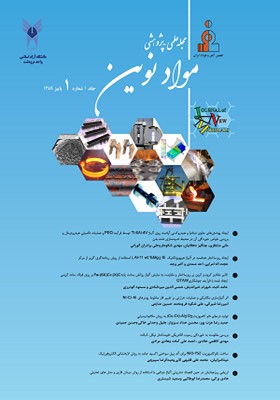مدل سازی دگرگونی تجزیه آستنیت در منطقه متاثر از حرارت جوش دو فولاد خط لوله X65 و X70
محورهای موضوعی : فصلنامه علمی - پژوهشی مواد نوین
1 - استادیار، گروه مهندسی مواد، دانشگاه آزاد اسلامی، واحد ساوه، ساوه، ایران
کلید واژه:
چکیده مقاله :
در این پژوهش شبیهسازی منطقه متاثر حرارتی جوشکاری ، بر مبنای شرایط عملی جوشکاری زیرپودری چهار سیمه در دو فولاد میکروآلیاژی X65 و X70، صورت گرفت. در ابتدا تحلیل چرخههای حرارتی منطقه متاثر حرارتی صورت گرفت. با اعمال چرخه های حرارتی گرم و سرد کردن تا دماهای قله 950، 1150 و °C1350، در دستگاه دیلاتومتری، رفتار دگرگونی و ساختار میکروسکوپی مورد مطالعه قرار گرفت. با افرایش دمای قله در دگرگونی، با وجود ثابت بودن سرعت سرد کردن (°C/s 23) در محدوده 800 تا°C 500، دماهای شروع و پایان دگرگونی به تاخیر میافتند و ساختارهای برشی جایگزین ساختارهای چندوجهی میگردد. علت این امر، درشت شدن دانه آستنیت و انحلال رسوبات کاربید نایوبیم و اثر تاخیری نایوبیم محلول در آستنیت است. اندازه بستههای برشی و اندازه دانه آستنیت اولیه نیز به طور محسوسی بزرگتر میشوند. با تحلیل نتایج دیلاتومتری، دیاگرام سرد کردن پیوسته و نیز سینتیک تجزیه آستنیت بررسی شد. مدل سازی تجزیه آستنیت با استفاده از معادله کلاسیک JMAK صورت گرفت. مشاهده شد که پارامتر n وابستگی زیادی به دما ندارد؛ در حالی که پارامتر k به شدت به دما، مقدار دگرگونی و اندازه دانه آستنیت وابسته است. نتایج مدل سازی دگرگونیهای فازی با استفاده از معادله JMAK توافق خوبی با نتایج دیلاتومتری داشت.
In this study, the simulation of the heat affected zone of welding was carried out based on the practical conditions of four-wire submerged arc welding in two X65 and X70 microalloy steel. Initially, thermal cycles of the heat affected zone were analyzed. By applying heating and cooling thermal cycles to peak temperatures of 950, 1150 and 1350 °C, in a dilatometric device, transformation behavior and microscopic structure were studied. With increasing peak temperature in transformation, despite the constant cooling rate (23 ° C / s) in the range of 800 to 500 ° C, the start and end temperatures of transformation are delayed and shear structures replace polygonal structures. The reasons are the coarsening of austenite grains, the dissolution of niobium carbide precipitates and the solute-drag effect of solved niobium in austenite.The size of the shear packs and the size of the austenite grains are also noticeably larger. By analyzing the dilatometry results, continuous cooling diagram and the kinetics of decomposition of austenite were investigated. Austenite decomposition modeling was performed using the JMAK classic equation. It was found that the parameter n has a small dependence on temperature; while the parameter k is strongly dependent to temperature, phase fraction transformed and austenite grain size. The results of modeling of phase transformations using the JMAK equation were in good agreement with the dilatometric results.


